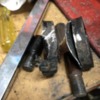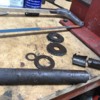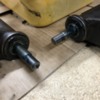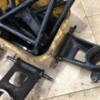Does anyone one have any hints on freeing seized lower pivot arms in the rear carrier assemblies without totally destroying the a arms or splitting the uprights in the process ?
The pivot shafts are locked / rusted internally onto the outer sleeve and just will not move. The inner brass sleeves are also plainly heavily worn . They have to be replaced.
Helpful directions like "gently tap out shaft " are not cutting it .
After having soaked them for days in WD40. I now have the carrier hub casting moving freely from the outer sleeve but its on the outer sleeve, not the through shaft joint to the inner sleeve. That is acting like a single item.
I have had both LH and RH assemblies set up in a 12 T press and applied hammering on the press piston and prudent heat on the carrier sleeve while having some pretty good pressure on the jack. Nothing.
My current strategy is a full kero and oil submersion bath for a week, and down the road to use a 20T press. What could possibly go wrong ??
Any other smart ideas from the brains trust before I explode one of the most highly expensive pieces of scrap metal not yet sold to the government?







